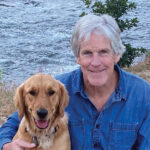How to Swim in Our Sea of Fake News
What matters is keeping your own story strong, lighthearted, and up to date
"Looking back, taking on the president of Random House, the Times, and Cronkite was not a great career move for a journalist. I had to self-publish my book and almost lost my faith in having a career in journalism. Fake news seemed everywhere—and coming from the top."
A couple of years ago, an article in the Boston Globe keelhauled me back to my own “dark night of the soul”—and the origins of S&H:
A new artifact is coming to the Whydah Pirate Museum in Yarmouth, Massachusetts: a caboose stove, used on the pirate ship Whydah.
“We just brought it in last night,” said Barry Clifford, who found the artifact in 2007. Clifford said he found the caboose about 23 years after he discovered the wreck of the Whydah in 1984, and he has preserved it ever since.
The Whydah caboose is famous because Henry David Thoreau mentioned seeing it from the beach in his book Cape Cod. I knew about the caboose because of my own book about the Whydah called Walking the Plank. My book has a map of the caboose drawn when it was first discovered by Clifford’s partner, Rob McClung, dated September 21, 1984. Another drawing from 1984 shows the position of the caboose among more than 40 cannons from the pirate ship.
Shortly after the pirate ship hit the sandbar off the beach, the Colonial governor sent Captain Cyprian Southack to salvage the treasure. Southack didn’t find much, but he reported back: “The Riches with the Guns will be buried in the sand.”
So now, dear reader, it’s time for some investigative journalism.
It’s September 1984; the pirate guns have been located; the riches are “with the Guns”; and also with the guns is a rusted old stove/caboose that one of America’s most famous authors wrote about because it was sticking out of the waves.
How much more treasure do you expect to find?
Hold that thought.
On October 5, 1984, Robert Bernstein, the president of Random House, his son Tom, a Wall Street mogul, and his partner, Roland Betts, took control of publicity for the wreck. The three men wrote a Media Plan that stated:
“The media we will cooperate with in the months ahead will be carefully selected to provide us with print and television coverage that will, in words and pictures, tell the story that we want to tell.”
The Media Plan led to a cover story in Parade (circulation 50 million) with the headline: “The Man Who Found a $400 Million Pirate Treasure!” Front-page stories in the New York Times heralded hundreds of millions. Ultimately, the Media Plan led to a CBS News Special in which Walter Cronkite, the most trusted man in America, announced “tons of gold” as well as a $6 million stock offering by Tom Bernstein and Roland Betts to pay for excavating the mother lode. Cronkite gave everything but an 800 number to sell the stock.
So, how much more treasure did you guess was left among the guns? (Hang on. I’ll bet you were right.)
The tons of gold never materialized. Instead, on October 12, 1989, investors learned the “disappointing results” of the ’89 field season that included this detail: “An attempt was also made to recover the ship’s stove, an artifact that was discovered and tagged during the 1988 field season.” Thoreau’s old stove proved to be a rotisserie—turning up again in 2007 to help launch a National Geographic exhibit called Real Pirates, and most recently to promote the Whydah museum in Yarmouth. (Clifford now claims there are two stoves; it’s not clear where or when the other will turn up.)
Looking back, taking on the president of Random House, the Times, and Cronkite was not a great career move for a journalist. I had to self-publish my book and almost lost my faith in having a career in journalism. Fake news seemed everywhere—and coming from the top. But one reason I pursued the story is that I was competing with my mentor T George Harris, who began his career as an artillery scout at the Battle of the Bulge in World War II. Working beyond the front lines, where “friendly” fire was as likely to kill you as the enemy, was an ultimate training ground for journalists. He saw the Holocaust firsthand and remained committed to finding the best in humanity. T George went on to become a Time reporter and then editor in chief of Psychology Today, American Health, and Harvard Business Review. I wanted to prove that I too could work beyond the front lines. After Walking the Plank, T George patched me up and brought me in for the launch of S&H. I am enormously proud of our last 20 years.
A reporter’s job is to seek truth—and the only real calamity is to lose faith in it. The spiritual journey is more difficult. We are the storytelling animal, and our stories shift to justify pretty much whatever we do. (See page 26) That’s why it’s really helpful to write your own story and publish it—and now it’s so easy. Twenty-five years later, you may find, as I did, that you have to rewrite yourself because the story evolved and so have you. I hope you’ll read my revised book—and write yours.


